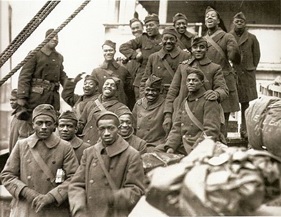
There’s a lot to be said about Memorial Day. And to start, let us remember that Memorial Day is an American-Black-US History holiday. A holiday observed on the last Monday of May, honoring the men and women who died while serving in the U.S. military. Originally known as Decoration Day, it originated in the years following the Civil War and became an official federal holiday in 1971. So, to be inclusive, be sure to remember African Americans served in the in the Civil War on both the Union and Confederate side. In the Union army, over 179,000 African American men served in over 160 units, as well as more serving in the Navy and in support positions. This number comprised of both northern free African Americans and runaway slaves from the South who enlisted to fight. In the Confederacy, African Americans were still slaves and they served mostly in labor positions. By 1865, the South allowed slaves to enlist but very few actually did.
And then, following the Civil War, the Army disbanded volunteer “colored” regiments, and established six Regular Army regiments of black troops with white officers. In 1869, the infantry regiments were reorganized into the 24th and 25th Infantry. The two cavalry regiments, the 9th and 10th, were retained. These regiments were posted in the West and Southwest where they were heavily engaged in the Indian War. During the Spanish-American War, all four regiments saw service.

When World War I broke out, there were four all-black regiments: the 9th and 10th Cavalry and the 24th and 25th Infantry. The men in these units were considered heroes in their communities. Within one week of Wilson’s declaration of war, the War Department had to stop accepting black volunteers because the quotas for African Americans were filled. Buffalo Soldiers originally were members of the U.S. 10th Cavalry Regiment of the United States Army, formed on September 21, 1866, at Fort Leavenworth, Kansas. This nickname was given to the “Negro Cavalry” by the Native American tribes they fought in the Indian Wars. The term eventually became synonymous with all of the African American regiments formed in 1866:
Many soldiers of color served their country with distinction during World War II. There were 125,000 African Americans who were overseas in World War II. Famous segregated units, such as the Tuskegee Airmen and 761st Tank Battalion and the lesser-known but equally distinguished 452nd Anti-Aircraft Artillery Battalion, proved their value in combat, leading to desegregation of all U.S. armed forces by order of President Harry S. Truman in July 1948 via Executive Order 9981.
 Benjamin O. Davis, Jr. served as commander of the Tuskegee Airmen during the war. He later went on to become the first African American general in the United States Air Force. His father, Benjamin O. Davis, Sr., had been the first African American brigadier general in the Army (1940).
Benjamin O. Davis, Jr. served as commander of the Tuskegee Airmen during the war. He later went on to become the first African American general in the United States Air Force. His father, Benjamin O. Davis, Sr., had been the first African American brigadier general in the Army (1940).
Doris Miller, a Navy mess attendant, was the first African American recipient of the Navy Cross, awarded for his actions during the attack on Pearl Harbor. Miller had voluntarily manned an anti-aircraft gun and fired at the Japanese aircraft, despite having no prior training in the weapon’s use.
In 1944, the Golden Thirteen became the Navy’s first African American commissioned officers. Samuel L. Gravely, Jr. became a commissioned officer the same year; he would later be the first African American to command a US warship, and the first to be an admiral.
Please follow me on Facebook https://www.facebook.com/JustImagineChildrensBooks/?ref=bookmarks
Twitter: tamarashiloh102
www.tamarashiloh.com
https://en.wikipedia.org/wiki/Military_history_of_African_Americans
http://www.militaryhistoryonline.com/wwi/articles/fightingforrespect.aspx